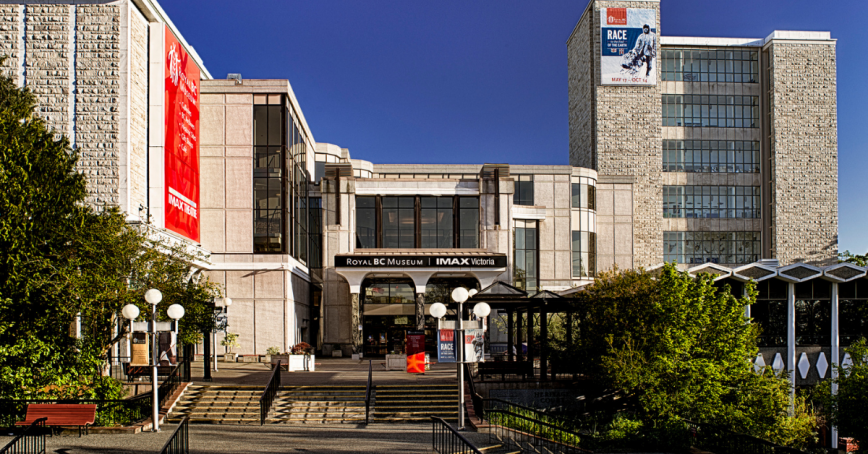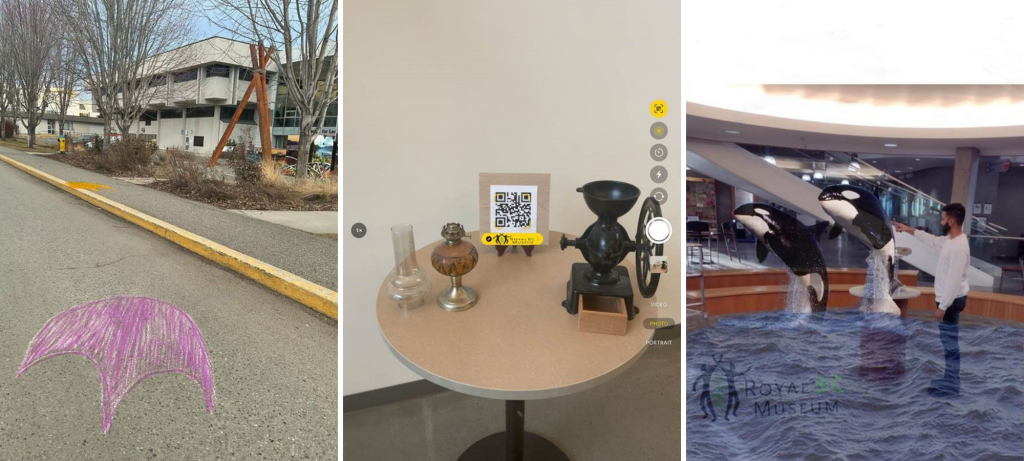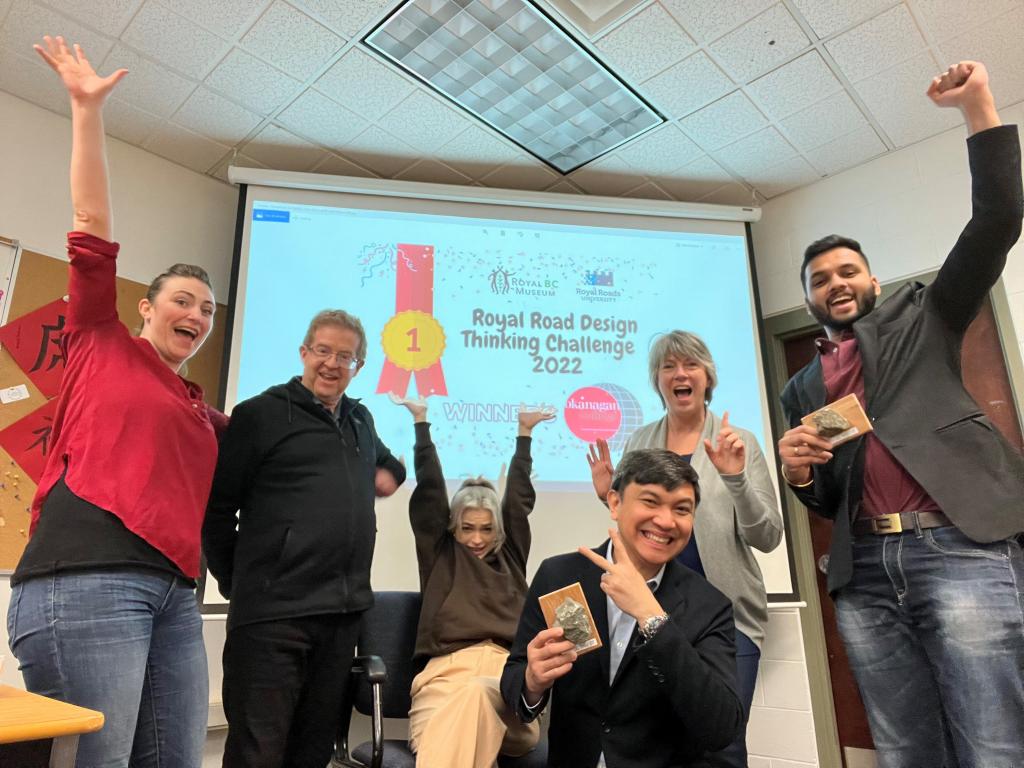Students curate solutions to make old stuff appeal to young audiences

Ten teams of university students from across Canada and the US put their problem-solving skills to the test during Royal Roads’ fifth annual Design Thinking Challenge, an event where business students compete against one another to create solutions to a real-world problem.
The challenge asked students to consider how this year’s client, the Royal BC Museum, might offer a more vibrant experience for the people and communities it serves. That question, the students learned, would start with considering the museums and galleries in their own hometowns and cities.
And it left Rebecca Thede with questions of her own.
The third-year Bachelor of Business Administration student at Okanagan College, who is a member of this year’s winning team, says she and her teammates had a perplexing moment upon hearing this year’s challenge question.
“All four of us just looked at each other and said, ‘are there even museums in the Okanagan?’ Like we had this moment. We didn’t know,” she says.
And that, they later learned, would be precisely the problem they would be asked to solve.
Over the course of four weeks, the challenge question was refined based on the student’s research, and challenges and goals identified by the RBCM – one of those being ways it can better reach non-traditional audiences.
“We definitely know that people come here as young kids with their families, but when they become teenagers and then university students, they are not coming back,” says Kim Gough, learning program developer for the RBCM.
By the third and final round, the challenge focused on how the RBCM might better appeal to post-secondary students like Thede, who may not even know it exists.
If they aren’t coming to you, go to them
Through interviews, surveys and face-to-face conversations with students, the team from Okanagan College learned that students thought of museums as expensive, boring and stale places that didn’t jive with their need for interactive experiences that connect them with their friends and community.
The students came up with a trio of innovative “out-of-the-norm” solutions designed to “spark students’ curiosity” while motivating them to learn more, says Okanagan team member Kent Dolera, who is pursuing a Diploma of Business Administration.
The team proposed that if students weren’t going to the museum, the museum should come to them.
Their idea included footprints, such as those of a dinosaur or woolly mammoth, boldly printed on city sidewalks, pop-up “this or that” exhibits where students could vote on one of two historical items they found most interesting, and projected digital artifacts or collections at places students frequent. All of these exhibits would offer the chance to connect further and learn more about the museum through a QR code.

The winning team provided prototypes for their interactive, community-based idea.

Okanagan College students Rebecca Thede, Chantelle Gaberel, Kent Dolera and Vasu Singla worked with coaches Pamela Nelson and Robert Ryan to promote inclusivity while modernizing the museum’s exhibits.
Good idea + quality research = win
The team impressed the judges with their creativity, but it wasn’t only their innovative solutions that helped them nab the first place, $6,000 prize.
Their selection of ideas was good, no doubt, says challenge co-organizer and Royal Roads School of Business associate faculty member, Michael Pardy. But it was their commitment to the design thinking process and the quality of their research that really set them apart.
“They really honoured the process,” Pardy says, emphasizing that design thinking is about cultivating a deep understanding about a problem before testing and retesting your ideas.
“They went out and actually drew footprints on sidewalks,” he says. “Design really is a process of discovery and their ideas were really well-supported by their testing.”
Gough says she was amazed at the creativity of the ideas presented from many of the teams.
“One I’m still thinking about was the idea for an escape room,” she says, which was proposed by students from the Rotman School of Business at the University of Toronto, who placed second.
The themed escape room would be decorated with objects and materials from a specific time period and exhibit. It would allow for an immersive, social experience while attracting young people to the museum.
“I was like ‘whoa!’ I hadn't thought of that at all!” says Gough, who has been with the RBCM for 15 years.
Teams from Royal Roads University and McMaster University tied for third place this year.
The McMaster University team was recognized for its idea to provide engaging experiences through conferences and interactive quiz kiosks tailored to groups of higher education students. The team learned museum visitors in BC were looking for an interactive and inspiring experience. Their idea was therefore designed to make students feel more connected with the community and the collections inside the RBCM.
Royal Roads University students impressed the judges with their idea of how the RBCM might engage undergraduate students from the BIPOC community (Black, Indigenous and people of colour) through the sharing of their own stories. Their solution, which aimed to tie history to both the present and the future, would feature BIPOC students as their own storytellers with the goal of curating a decolonized view of historical subjects.
“This Design Thinking Challenge came at a really good time for us,” says Gough, alluding to the RBCM’s current multi-year process to re-envision how it shares BC’s rich, diverse and complex histories.
“The challenge felt rejuvenating and exciting,” she says, noting plans are already in place to share the student’s ideas more broadly at the museum.
As for Thede, she says she’s now not only familiar with the museums in her own community (there are half-a-dozen or so, she’s learned) but she can now see the invaluable benefits of empathetic design.
“One of the quotes I came across in this process was, ‘the right answer to the wrong question is still the wrong answer.’ To me, that kind of defines what design thinking is about, because if you don’t have the question right and you don’t really understand what people need, you can’t give them a solution.”